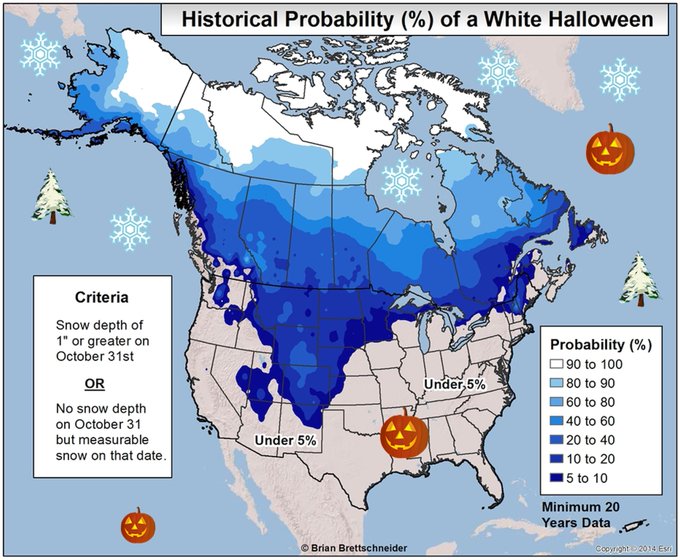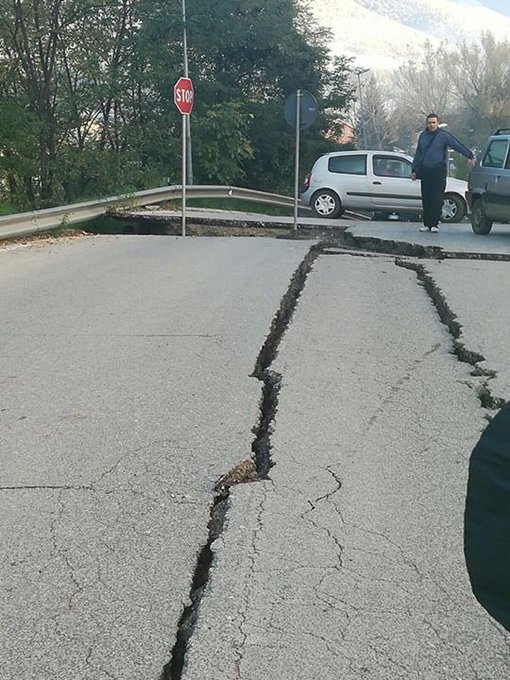October 31,2016
After central Italy was rocked
by a 6.6 magnitude earthquake Sunday morning, experts say they can't
exclude the possibility that there will be more, possibly stronger
aftershocks in the area near Norcia .
British Geological Survey
seismologist Margarita Segou told the Associated Press that the
important thing to realize is that, while the number of temblors will
decline over time, "we cannot exclude the possibility of larger
magnitude aftershocks.
Carlo Doglioni, president of Italy's
National Institute for Geophysics and Vulcanology, Carlo Doglioni, told
The Associated Press that the intense activity along a series of faults
in the region wasn't anomalous and that more significant quakes can be
expected.
He said there was a similar sequence of three seismic
events within a period of months in 1703, adding "it is normal for the
Apennines," where there are a series of interdependent faults.
Doglioni
said that natural law dictates that after such an event that there will
be more quakes, "which means we can expect some 5 magnitude quakes and
many of magnitude 4."
(MORE: Two Faults 'Holding Hands' Could Unleash Huge California Quake)
The USGS says the
quake was centered about 4 miles north of Norica, Italy, and hit at
7:40 a.m. local time. Last Wednesday's 6.1 and 5.5 magnitude earthquakes
were also centered in this same general area, along with many
aftershocks in the following days.
There were no immediate reports
of deaths, but about 20 people had suffered injuries as numerous
buildings that had resisted the previous temblors collapsed.
Prime
Minister Matteo Renzi said the nation's "soul is disturbed" by the
series of quakes that began with the deadly Aug. 24 quake that killed
almost 300 people.
He has vowed that the country will rebuild the
homes, churches and other structures destroyed by the temblor, which is
the latest to strike the region since Wednesday.
"We will rebuild
everything - the houses, the churches, the shops," said Renzi. "We are
dealing with marvelous territories, territories of beauty. These
villages are the identity of Italy. We must reconstruct them all,
quickly and well."
Residents already rattled by a constant
trembling of the earth rushed into piazzas and streets after being
roused from bed by the 7:40 a.m. quake.
Many people still had been
sleeping in cars or evacuated to shelters or hotels in other areas
after a pair of strong jolts on Wednesday. Curcio said 1,300 had been
evacuated to the coast, and more would follow.

Rubble
of a collapsed building in L'Aquila, central Italy, after an earthquake
with a preliminary magnitude of 6.6 struck central Italy, Sunday, Oct.
30, 2016. A powerful earthquake rocked the same area of central and
southern Italy hit by quake in August and a pair of aftershocks last
week, sending already quake-damaged buildings crumbling after a week of
temblors that have left thousands homeless. (Alberto Orsini/ANSA via AP)
The
quake struck a cluster of mountain towns, many of historic
significance, already reeling from last week's pair of aftershocks to an
August earthquake that killed nearly 300: Norcia, Visso,
Castelsantangelo sul Nero and Preci.
The head of the civil
protection authority in Italy's Marche region, Cesare Spuri, said there
were reports of buildings collapsing in many cities.
"We are trying to understand if people are under the rubble," Spuri said.
In
the ancient city of Norcia, famed for its Benedictine monastery and its
cured meats, witnesses said the 14th century St. Benedict cathedral
crumbled, leaving only its facade standing.
Television images in
the minutes after the quake showed nuns rushing out of their church and
into Norcia's main piazza as the clock tower appeared ready to fall. One
nun had to be carried by firefighters, while another was supported as
she walked. Later, priests and nuns prayed in the square amid the
rubble.
"It's as if the whole city fell down," Norcia city assessor Giuseppina Perla told the ANSA news agency.
The
town closest to the quake's epicenter, Norcia is the birthplace of St.
Benedict, the father of monasticism and has suffered a series of
earthquakes over its history. The cathedral was built over Benedict's
birthplace.
The monks of Norcia confirmed the collapse of the St.
Benedict cathedral in a letter launching an immediate fundraising
campaign to rebuild.
The
current superior, who signed the letter to supporters as the Rev.
Benedict, reported the cathedral was "flattened," and that monks were
combing the city to help where needed.
"May this image serve to
illustrate the power of this earthquake, and the urgency we monks feel
to seek out those who need the sacraments on this difficult day for
Italy," he wrote.
The deputy mayor of Norcia, Pierluigi Altavilla, said his house remained standing, but everything inside had been toppled.
"It seemed like a bomb exploded inside the house," he told Sky TG24.
The
hilltop town of Camerino, some 60 kilometers from Ancona, suffered new
building collapses but no reports of injuries. City spokesman Emmanuele
Pironi said the main fire hall had been rendered uninhabitable and that
they had transferred to a warehouse.
"An hour and a half after the quake, we can be reassured," Pironi told The Associated Press.
Pironi
said most of the area's 9,000 university students had left after the
town's historic center was closed due to danger of collapses last week,
and some of the 7,000 residents had been moved to hotels near the coast
or to shelters nearby. Few remained in their homes.
The mayor of quake-hit Ussita said a huge cloud of smoke erupted from the crumbled buildings.
"It's a disaster, a disaster!" Mayor Marco Rinaldi told ANSA. "I was sleeping in the car and I saw hell."
In
Arquata del Tronto, which had been devastated by the Aug. 24 earthquake
that killed nearly 300 people, Arquata Mayor Aleandro Petrucci said,
"There are no towns left."
"Everything came down," he said.
New collapses also were reported in Tolentino, where the news agency ANSA said three people were extracted from the rubble.
The
quake was felt throughout the Italian peninsula, with reports as far
north as Bolzano near the Austrian border and as far south as Bari in
the Puglia region. Residents rushed into the streets in Rome, where
ancient palazzi shook, swayed and lurched for a prolonged spell.
Austria's
governmental earthquake monitoring organization said the quake was felt
to varying degrees in the east and south of the country and all the way
to the city of Salzburg. It says that at its strongest, residents in
upper floors noticed a swaying sensation and a slow swinging of hanging
objects.
The quake sent boulders raining onto state highways and
smaller roads, forcing closures throughout the quake zone that was
impeding access to hard-hit cities such as Norcia. Traffic was being
diverted to other roads.
The Salaria highway, one of the main highways in the region, was closed at certain points as it was after Wednesday's quakes.
In addition, Italy's rail line said some local lines in Umbria and Le Marche were closed as a precaution.
The
European-Mediterranean Seismological Center put the magnitude at 6.6 or
6.5 with an epicenter 132 kilometers northeast of Rome and 67
kilometers east of Perugia, near the epicenter of last week's temblors.
The U.S. Geological Survey put the magnitude at 6.6.
The German
Research Centre for Geosciences put the magnitude at 6.5 and said it had
a depth of 10 kilometers, a relatively shallow quake near the surface
but in the norm for the quake-prone Apennine Mountain region.







 (Photo/The Kobi Company/Steven Waelbers)
(Photo/The Kobi Company/Steven Waelbers) (Photo/The Kobi Company)
(Photo/The Kobi Company)





 Rubble
of a collapsed building in L'Aquila, central Italy, after an earthquake
with a preliminary magnitude of 6.6 struck central Italy, Sunday, Oct.
30, 2016. A powerful earthquake rocked the same area of central and
southern Italy hit by quake in August and a pair of aftershocks last
week, sending already quake-damaged buildings crumbling after a week of
temblors that have left thousands homeless. (Alberto Orsini/ANSA via AP)
Rubble
of a collapsed building in L'Aquila, central Italy, after an earthquake
with a preliminary magnitude of 6.6 struck central Italy, Sunday, Oct.
30, 2016. A powerful earthquake rocked the same area of central and
southern Italy hit by quake in August and a pair of aftershocks last
week, sending already quake-damaged buildings crumbling after a week of
temblors that have left thousands homeless. (Alberto Orsini/ANSA via AP)
 Temperatures
compared to average Oct. 1-24, 2016. Areas shaded orange and brown have
seen temperatures the farthest above average overall.
Temperatures
compared to average Oct. 1-24, 2016. Areas shaded orange and brown have
seen temperatures the farthest above average overall.


 (Thinkstock/Zoonar/Zoonar RF)
(Thinkstock/Zoonar/Zoonar RF)






